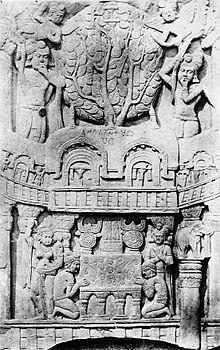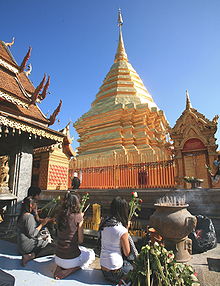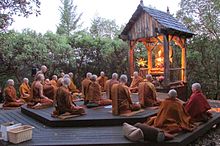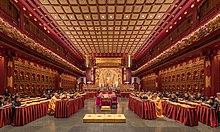Offering (Buddhism)

 |
| Buddhist devotional practices |
|---|
| Devotional |
| Holidays |
| Precepts |
| Other |
In Buddhism, a Pūjā (offering or worship) is a rite made to a Buddha, deity or to the Triple Gem, giving rise to contemplative gratitude, inspiration and blessings (adhiṣṭhāna) from the Buddhas.[2]
Common elements of a Buddhist Pūjā include the recitation of certain formulas, prayers, and texts (such as parittas, sutras or dharanis) as well as material offerings such as a lit candle or oil lamp,[3] burning incense,[4] flowers,[5] food, fruit, water or drinks.[6]
Within the traditional Buddhist framework of karma and rebirth, Pūjās lead to the accumulation of merit (Sanskrit: puṇya; Pali: puñña), which leads to: a better rebirth in the cycle of birth and death (Pali: vaṭṭagāminī-kusala) as well as progress towards release from suffering (Pali: vivaṭṭagāminī-kusala).[7][8]
A Pūjā can also act as preparation for meditation.[9]
Theravada
[edit]

In some Theravada traditions, two different types of offerings are identified: material or hospitality offerings (Pali: amisa-puja or sakkara-puja) and practice offerings (Pali: patipatti-puja).[10][11][12][13]
Material offering
[edit]Material offerings are considered external offerings of "words and deeds."[13] Material offerings nurture generosity (Pali:dāna) and virtue (Pali: sīla).[14] The act further honors the Triple Gem (the Buddha, Dhamma and Sangha), deepening one's commitment to the Buddha's path.
Material offerings might be imbued with the following symbology:
- the lighting of a candle or an oil lamp represents the light of wisdom illuminating the darkness of ignorance.
- the burning of incense represents the fragrant scent of morality.
- flowers represents the aspiration to achieve the body of the Buddha with the thirty-two marks of the Buddha as well as the teaching of impermanence. Alternately, a Zen verse expresses the desire for the mind's "flowers" to "bloom in the springtime of enlightenment."[15]
- food, fruit, water, drinks represents the nectar of Dharma and the wish to achieve it.
Traditional chants in Pali, when offering lit candles (padīpa pūjā) and incense (sugandha pūjā) to an image of the Buddha are:
| Ghanasārappadittena Dīpena tama-dhaṃsinā |
With lights brightly shining |
Similarly, a traditional Pali incense-lighting verse speaks of the Buddha's "fragrant body and fragrant face, fragrant with infinite virtues."[18]
By contemplating on an offering, one tangibly sees life's impermanence (Pali: anicca), one of the three characteristics of all things upon which the Buddha encouraged his disciplines to recollect. For instance, the end of a traditional chant in Pali, when offering flowers (puppha pūjā) to an image of the Buddha is:
| Pujemi Buddham kusumenanena Puññenametena ca hotu mokkham |
I worship the Buddha with these flowers; |
Non-material offerings
[edit]Practice offerings may be manifested by practicing:
In the Pali Canon, the Buddha declared practice offerings (Patipatti) as "the best way of honoring the Buddha"[21] and as the "supreme" offering.[13] This is primarily an internal offering for mental development (Pali: citta, bhāvanā and samādhi).
"But Ananda, whatever bhikkhu or bhikkhuni, layman or laywoman, abides by the Dhamma, lives uprightly in the Dhamma, walks in the way of the Dhamma, it is by such a one that the Tathagata is respected, venerated, esteemed, worshipped, and honored in the highest degree." (Taken from Mahāparinibbāṇa Sutta, Dīgha Nikāya)[22]
Mahayana
[edit]


In Mahayana Buddhism, a puja (Chinese: 供養; Tibetan: cho, Wylie: mchod) often involves ritual offerings, prayers, and the chanting of Mahayana sutras, dharanis and mantras. It is an important practice in Mahayana tradition, where it serves to cultivate a sense of refuge and devotion to the Buddha, bodhisattvas, and other revered figures as well as to cultivate other spiritual qualities. Puja can be performed individually or in a group and is typically conducted in temples or monasteries, although it can also be done in home altars.
Mahāyāna pujas often follow standard liturgical forms, such as the triskandhaka (three-part) and saptānga-vidhi (seven-part) rituals.[23] These are classic Indic Mahayana pūjā forms. They initially derived from a basic three-part liturgy which consists of:[23]
- Confession of transgressions (pāpadeśanā),
- Admiration of others’ virtues (anumodana),
- Dedication of merit (parināmanā).
The second version of the three-part ritual is similar but adds a request to the buddhas to turn the wheel of the dharma (dharmacakrapravartana) instead of merit dedication.[23]
The ritual expanded over time to include more elements. In one sūtra translated into Chinese in 2nd century named the Dispelling the Regrets of Ajātaśatru Sūtra, a five-part puja is outlined which consists of:[24]
- Refuge in the triple gem,
- Confession of transgressions,
- Rejoicing in the virtues of others,
- Requesting the buddhas to teach,
- Giving rise to bodhicitta
Over time, this grew into a more elaborate seven-part liturgy (saptāṅgavidhi, saptāṇgapūjā or saptavidhā anuttarapūjā), which includes:[23]
- Obeisance or praise (Sanskrit: vandanā)
- Offerings or worship (pūjana)
- Confession of bad deeds (pāpadeśanā)
- Rejoicing (anumodana)
- Request for the buddhas and bodhisattvas to teach the dharma (saṃcodana or dharmacakrapravartanacodana)
- Entreaty for the buddhas not to enter parinirvāṇa (prārthanā or aparinirvṛtādhyeṣaṇa)
- Dedication of the merit from the ritual to the enlightenment of all sentient beings (pariṇāmanā)
This seven-part liturgy, notably found in the Bhadacaryāpranidhāna ("Vow of Samantabhadra's Deeds"), a part of the Gandavyūha section of the Avataṃsakasūtra, became a central element in many Mahāyāna practices. In Tibetan Buddhism, the seven part puja is a common structure adopted in many rituals and prayers. It is frequently recited before meditation sessions and is also a key feature in tantric pūjās.[23]
The specific actions in a Mahāyāna puja vary considerably depending on the tradition, but it generally includes offerings such as water, flowers, incense, fragrant food, and light (candles, butterlamps, etc).[25] These are taken to symbolize respect and reverence for the Buddhas and bodhisattvas. Pujas may also involve the chanting or recitation of specific ritual texts or sadhanas, and the names or mantras of Mahayana Buddhas and bodhisattvas, such as Avalokiteshvara, Amitabha, and Manjushri. All these actions are believed to invoke blessings, purify the mind, and cultivate merit. Pujas may also include other practices like prostrations. The Mahayana view of a puja reflects the ideal of the bodhisattva, as such it is often accompanied by prayers for compassion, for bodhicitta, the attitude to attain Buddhahood for the sake of all beings, and the bodhisattva vows.
East Asian Buddhist rituals contain many of the classic elements of the Indian puja rituals. For example, many of the elements of the Indian pujas can be found in the Lotus Samādhi outlined by the Tiantai patriarch Zhiyi in his Great Calming and Contemplation. As noted by Swanson, this practice contains the following ten elements: [26]
- Arrange and purify the room: the room must be cleaned, a copy of the Lotus sutra in placed a dais, incense is lit, a so on.
- Purification of the body: bathing in scented water and changing to clean clothing
- Making physical, verbal, and mental offerings: this includes ritual prostration, giving rise to bodhicitta, and the recitation of a prayer to the three jewels.
- Petitioning the Buddhas and bodhisattvas: one recites several ritual formulas
- Paying homage to the Buddhas through the recitation of several verses and formulas.
- The “fivefold repentance”: (1) repenting the offences one has committed through the six senses, (2) ask the buddhas to teach Dharma, (3) rejoicing in the virtue of buddhas and bodhisattvas, (4) transferrence of merit, (5) sincerely taking the bodhisattva vows to save all beings.
- Circumambulating a buddha statue while reciting phrases of homage
- Reciting the Lotus Sūtra (either the whole sutra or in part)
- Sitting meditation contemplating the nature of all things
- Realizing the true nature of reality
See also
[edit]- Buddhānussati
- Sacca-kiriya
- Learning the Buddha Dhamma
- Dana (Buddhism)
- Ethical Conduct (Buddhism)
- Spiritual Cultivation (Buddhism)
- Contemplation (Buddhism)
- Meditation (Buddhism)
- Chanting (Buddhism)
- Devotion (Buddhism)
- Householder (Buddhism)
Notes
[edit]- ^ Mahâbodhi, Cunningham p.4ff
- ^ See, for instance, Harvey (1990), pp. 172-3.
- ^ Indaratana (2002), pp. iv, v; Kapleau (1989), p. 193; Khantipalo (1982); Lee & Thanissaro (1998).
- ^ Indaratana (2002), pp. 11-12.
- ^ See, for instance, Indaratana (2002), pp. 11-12. Harvey (1990), p. 173, and Kariyawasam (1995), chapter 1, both maintain that flowers are the most common form of offering.
- ^ Kapleau (1989), p. 193; Khantipalo (1982); and, Harvey (1990), p. 175, particularly in regards to Northern Buddhism.
- ^ Lee & Thanissaro (1998). See also Harvey (1990), p. 173, who in discussing "offerings" states: "Such acts consequently generate 'merit'."
- ^ www.wisdomlib.org (2010-01-27). "Purity Of Sila [Chapter 5]". www.wisdomlib.org. Retrieved 2024-08-20.
- ^ See, for instance, Indaratana (2002), p. v; Kapleau (1989), pp. 191ff.; and Khantipalo (1982).
- ^ Khantipalo (1982); Lee & Thanissaro (1998).
- ^ Khantipalo (1982).
- ^ See also Alms#Buddhism regarding the traditional Theravada offering of providing daily alms to bhikkhus.
- ^ a b c Lee & Thanissaro (1998).
- ^ See, for instance, Lee & Thanissaro (1998).
- ^ Harvey (1990), p. 173.
- ^ a b Indaratana (2002), p. 12.
- ^ Indaratana (2002), p. 11. See also Harvey (1990), p. 175, who translates the light-offering verse in part as describing the Buddha as "the lamp of the three worlds, dispeller of darkness."
- ^ Harvey (1990), p. 175.
- ^ Indaratana (2002), p. 11. Similarly, see Harvey (1990), p. 173; and, Kariyawasam (1995), ch. 1, sect. 2, "Personal Worship."
- ^ Khantipalo (1982); and, Nyanaponika (2000), pp. 298-299. On the other hand, Lee & Thanissaro (1998) identify only meditation as patipatti-puja.
- ^ Kantipalo (1982), n. 1.
- ^ "Maha-parinibbana Sutta: Last Days of the Buddha".
- ^ a b c d e Buswell, Robert E; Lopez, Donald S. The Princeton Dictionary of Buddhism, p. 679. Princeton University Press, Nov 24, 2013.
- ^ Crosby, Kate; Skilton, Andrew. The Bodhicaryavatara pp 9-10. Oxford World's Classics, 2008.
- ^ Harvey (1990), p. 175.
- ^ Swanson, Paul L. Clear Serenity, Quiet Insight T'ien-t'ai Chih-i's Mo-ho chich-kuan, Volume I, pp. 305-311. University of Hawaii Press, 2017.
Bibliography
[edit]- Harvey, Peter (1990). An introduction to Buddhism: Teachings, history and practices. Cambridge: Cambridge University. ISBN 0-521-31333-3.
- Indaratana Maha Thera, Elgiriye (2002). Vandana: The Album of Pali Devotional Chanting and Hymns. Penang, Malaysia:Mahindarama Dhamma Publication. Retrieved 2007-10-22 from "BuddhaNet" at [1]
- Kariyawasam, A.G.S. (1995). Buddhist Ceremonies and Rituals of Sri Lanka (The Wheel Publication No. 402/404). Kandy, Sri Lanka: Buddhist Publication Society. Retrieved 2007-10-23 from "Access to Insight" (1996 transcription) at http://www.accesstoinsight.org/lib/authors/kariyawasam/wheel402.html#ch3.
- Kapleau, Philip (1989b). Zen: Merging of East and West. NY:Anchor Book. ISBN 0-385-26104-7.
- Khantipalo, Bhikkhu (1982). Lay Buddhist Practice: The Shrine Room, Uposatha Day, Rains Residence (The Wheel No. 206/207). Kandy, Sri Lanka:Buddhist Publication Society. Retrieved 2007-10-22 from "Access to Insight" (transcribed 1995) at http://www.accesstoinsight.org/lib/authors/khantipalo/wheel206.html.
- Lee Dhammadharo, Ajaan & Thanissaro Bhikkhu (trans.) (1998). Visakha Puja. Retrieved 2007-10-22 from "Access to Insight" at http://www.accesstoinsight.org/lib/thai/lee/visakha.html.
- Nyanaponika Thera (2000). The Vision of Dhamma: Buddhist Writings of Nyanaponika Thera. Seattle: BPS Pariyatti Editions. ISBN 1-928706-03-7.
- Soni, R.L. & Bhikkhu Khantipalo (2006). Life's Highest Blessings: The Maha Mangala Sutta. Retrieved 2007-10-22 from "Access to Insight" at http://www.accesstoinsight.org/lib/authors/soni/wheel254.htm[permanent dead link].
External links
[edit]- About the Buddha-altar Soto Zen home altar with offerings.
- The Consecration Ritual
- Virtual Puja at Emerald Buddha Temple-วัดพระแก้ว
